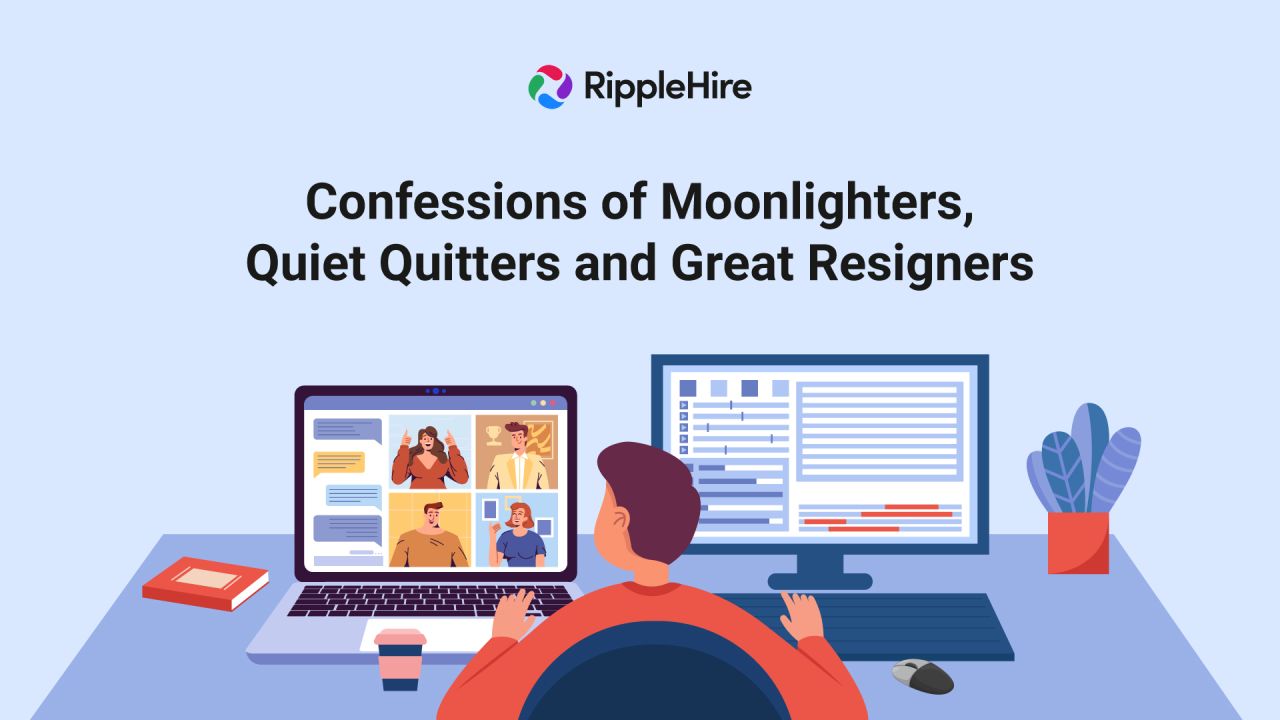Recruiters and talent acquisition professionals, are you feeling frustrated with the rising trends of moonlighting, quiet quitters, and great resigners? You’re not alone. Many employers are struggling to retain their top talent as the job market becomes increasingly competitive.
Perhaps you’ve invested time and resources into onboarding and training, only to have your star employee walk out the door for a better opportunity. Or maybe you’ve noticed a pattern of disengagement and apathy among your workforce, leaving you feeling unsure of how to address the issue.
It’s understandable to feel overwhelmed and even a little discouraged by these trends. But before you throw in the towel, let’s take a closer look at what’s driving this behavior and how you can effectively manage it.
In this article, we’ll delve into the world of moonlighting, quiet quitters, and great resigners and explore some practical strategies for retaining your top talent and attracting new hires. We promise to provide insights that can help you turn this challenge into an opportunity to build a stronger, more engaged workforce.
What is Moonlighting and How to Deal With It?
Moonlighting, or working a second job in addition to a full-time job, has become increasingly common in recent years. While moonlighting can provide employees with extra income and a chance to pursue their passions, it can also create conflicts of interest and other issues in the workplace.
To deal with moonlighting, employers should have clear policies in place that outline what is and is not acceptable. This policy should address conflicts of interest, confidentiality, and intellectual property, and should be communicated clearly to all employees.
Employers should also be proactive in identifying moonlighters within their organization. Signs of moonlighting may include decreased productivity, missed deadlines, and fatigue. By identifying moonlighters early, employers can address any conflicts of interest and ensure that their employees are working toward the company’s best interests.
To encourage employees to pursue their passions within the company rather than seeking outside employment, employers could create a side hustle program. This program could provide opportunities for employees to pursue their interests while also contributing to the company’s success. For example, an employee who is passionate about photography could be given the opportunity to take photos for the company’s marketing materials or social media accounts.
What are Quiet Quitters and How to Deal With Them?
Quiet Quitters are employees who have mentally checked out of their jobs but have not yet resigned. They may appear disengaged or apathetic, which can negatively impact team morale and productivity.
To address Quiet Quitters, employers should be proactive in seeking feedback from employees and creating an environment where feedback is valued and acted upon. Signs of Quiet Quitters may include decreased productivity, missed deadlines, and lack of interest in professional development opportunities.
To address the underlying issues that may be causing Quiet Quitters, employers could offer opportunities for growth and development such as training programs, mentorship opportunities, and career coaching. Encouraging employees to take sabbaticals could also provide them with a chance to recharge and refocus, ultimately leading to increased engagement and productivity upon their return.
What are Great Resigners and How to Deal With Them?
Great Resigners are high-performing employees who have a significant impact on the company but have decided to resign. Their departure can be difficult to replace and can have a significant impact on the company’s bottom line and morale.
To address Great Resigners, employers should understand the reasons behind their departure and address any underlying issues. Offering opportunities for growth and development, such as training programs and mentorship opportunities, could help employees feel more valued and appreciated. Additionally, creating a “stay interview” program to gather feedback from employees and address any concerns they may have could help prevent future resignations.
Finally, it’s important for employers to recognize that employees have more options than ever before when it comes to their careers. By creating a positive and engaging workplace culture, employers can attract and retain top talent and ensure their continued success.
As a recruiter or talent acquisition professional, you may be feeling overwhelmed by the rise of Moonlighting, Quiet Quitters, and Great Resigners. It’s natural to feel frustrated or even discouraged by the impact these trends can have on your organization.
But here’s the thing: these challenges can also be opportunities. By understanding and addressing these trends, you can create a more engaged and loyal workforce, and position your organization for long-term success.
What Should the Employer do to Deal With Moonlighting, Quiet Quitting, and Great Resigning?
While moonlighting, quiet quitting, and great resigning can be frustrating for recruiters and talent acquisition professionals, it’s important to remember that these trends can also be opportunities for growth and improvement. By addressing the underlying issues that cause these behaviors and creating a positive work environment, employers can build a stronger, more engaged workforce that is dedicated to the success of the organization.
One way to turn these challenges into opportunities is to create a culture of transparency and communication. When employees feel valued and heard, they are more likely to be engaged and committed to the organization. Employers can foster this culture by actively seeking feedback from employees and addressing any concerns or issues in a timely and effective manner.
Another way to address these challenges is to invest in the development and growth of employees. Offering training programs, mentorship opportunities, and career coaching can help employees feel valued and appreciated, and can ultimately lead to increased engagement and productivity. Additionally, employers can encourage employees to take sabbaticals or pursue their passions within the company through a side hustle program, providing opportunities for growth and development while also contributing to the company’s success.
It’s also important for employers to recognize the unique needs and motivations of each employee. By understanding what drives each individual, employers can tailor their approach to retention and engagement to meet those needs. For example, an employee who values work-life balance may benefit from a flexible schedule or the option to work from home, while an employee who is motivated by career advancement may benefit from a clear career path and regular performance reviews.
To further support employee engagement and retention, employers can focus on creating a positive work environment that fosters collaboration, innovation, and teamwork. This can be achieved by promoting a culture of inclusivity and diversity, offering team-building activities, and providing opportunities for employees to participate in company initiatives and projects.
Ultimately, the key to addressing moonlighting, quiet quitting, and great resigning is to be proactive, transparent, and supportive. By understanding the underlying issues and motivations that drive these behaviors, employers can develop targeted strategies that address those issues and create a positive work environment that fosters engagement and retention.
Final thoughts
Perhaps you’ve been struggling to retain your top talent and feel like you’re constantly playing catch-up. Or maybe you’re tired of dealing with disengaged or apathetic employees who are dragging down team morale.
Whatever your situation may be, know that you’re not alone. Many organizations are facing similar challenges, and it’s up to you to take action and turn these challenges into opportunities.
By embracing unconventional and highly surprising points for dealing with Moonlighting, Quiet Quitters, and Great Resigners, you can create a positive and engaging workplace culture that attracts and retains top talent. Whether it’s offering opportunities for growth and development, creating a side hustle program, or encouraging employees to take sabbaticals, there are many ways to address these trends and create a more engaged and loyal workforce.
So, don’t let these challenges get you down. Instead, embrace them as opportunities to build a stronger and more successful organization. By taking action today, you can position your organization for long-term success and create a positive and engaging workplace culture that attracts and retains top talent.






